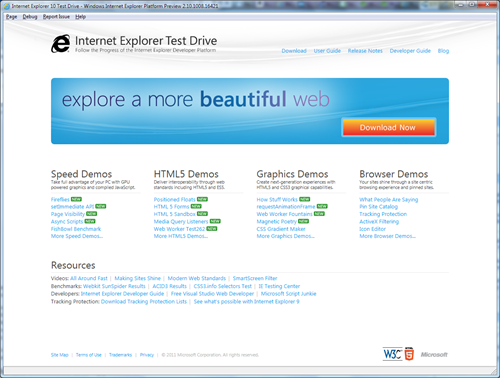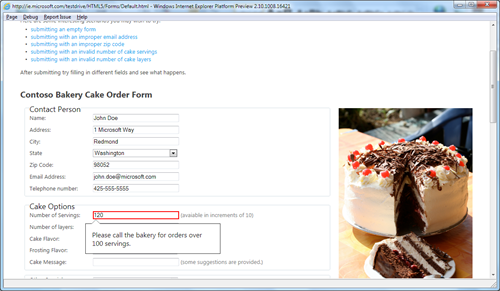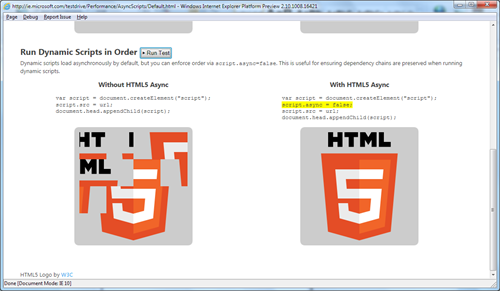IE10 PP2 released: WebWorkers, Drag & Drop, File API, CSS3 Positioned Floats, HTML5 Forms and more
(although on Habré there is already a short post-note about the release of IE10 PP2, in this article we want to give a more correct and complete overview of what is new in IE10 PP2).
And so, in accordance with the announced release date of the PP-versions for the next versions of IE once every ~ 12 weeks, we have released the next update. IE10 PP2 also looks like all previous Platform Preview versions, and the most interesting, as always, inside is the updated Internet Explorer engine:

')
⇒ Download link ⇐
ps Restrictions on the number of connected CSS-files, CSS-rules in them and nesting levels are significantly extended: up to 65534 rules per file, up to 4095 files per document and up to 4095 nesting levels. (thanks to TheBits for the tip)
And so, in accordance with the announced release date of the PP-versions for the next versions of IE once every ~ 12 weeks, we have released the next update. IE10 PP2 also looks like all previous Platform Preview versions, and the most interesting, as always, inside is the updated Internet Explorer engine:

')
⇒ Download link ⇐
What's new in IE10 PP2?
Standards - as they grow up and become stable, we move on to implementing them directly in Internet Explorer (recall that raw standards are cultivated in html5labs ):- CSS3 Positioned Floats is a new module within CSS3 that adds the ability to wrap content (for example, text) around inserted blocks. How it works can be seen in the example of Positioned Floats at ietestdrive.com:
- HTML5 Drag & Drop - IE9 and previous versions already supported the ability to drag elements with corresponding events and dataTransfer objects, IE10 PP2 added support for the draggable attribute and the ability to drag and drop files from the OS.
- File Reader API - finally, the standard has stabilized enough and it's time to move from an experimental implementation in HTML5Labs to an implementation directly in the browser engine.
- Media Query Listeners - as you know, CSS3 Media Queries allow you to dynamically change the applied CSS rules depending on various parameters (for example, screen size). With the help of Media Query Listeners (via CSSOM View ), you can now track these changes to process them through a script. See the Media Query Listeners example.
- HTML5 Forms with the ability to validate input values and support a number of new attributes that describe these features.

- Web Workers - allow background execution of scripts without blocking the UI - see the examples Web Worker Test262 and Web Worker Fountains (here also uses Channel Messaging support).

- asynchronous execution of scripts (async) is both a possibility of non-blocking asynchronous loading of scripts, and the ability to explicitly indicate that the sequence of dynamic loaded scripts should be synchronized. See the Async Scripts example.

- HTML5 Sandbox for iframe isolation - this attribute imposes significant restrictions on what can happen inside the inserted iframe (for example, scripts are disabled by default, forms are sent, plugins work, etc. - if necessary, the necessary elements can be resolved). How this works can be seen in the HTML 5 Sandbox example.
- Improvements to the parsing rules described by the HTML5 specification - now you can expect documents to be parsed equally in all compatible browsers, even in the case of incorrect markup.
- HTML5 Canvas API - Composition Models . You can see how this works in different browsers using the example of How Stuff Works :

- Performance APIs - to improve (and measure) performance, including support for setImmediate , requestAnimationFrame, and PageVisibility . See related examples on the IETestDrive: setImmediate API , requestAnimationFrame API and Page Visibility API .

ps Restrictions on the number of connected CSS-files, CSS-rules in them and nesting levels are significantly extended: up to 65534 rules per file, up to 4095 files per document and up to 4095 nesting levels. (thanks to TheBits for the tip)
Source: https://habr.com/ru/post/123182/
All Articles